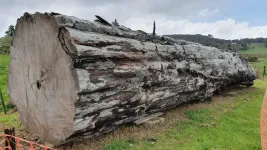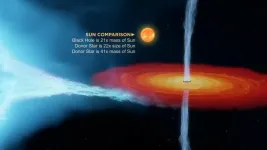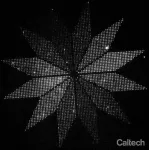INFORMATION:
Magnetic reversal 42,000 years ago triggered global environmental change
2021-02-18
(Press-News.org) Nearly 42,000 years ago, when Earth's magnetic fields reversed, this triggered major environmental changes, extinction events, and long-term changes in human behavior, a new study reports. The findings, made possible by a new radiocarbon record derived from New Zealand's ancient kauri trees, raise important questions about the evolutionary impacts of geomagnetic reversals and excursions throughout the deeper geological record, the authors say. "Before this work," says author Chris Turney in a related video, "we knew there were a lot of things happening around the world at 42,000 years ago, but we didn't know precisely how... For the first time, we've been able to precisely date what happened when Earth's magnetic fields last flipped." Written in the geological record are numerous instances where the planet's magnetic poles flipped. Today, such an event would almost certainly wreak havoc with modern electronic and satellite technologies. However, the potential environmental impacts of such events are virtually unknown. The most recent major magnetic inversion, the Laschamps excursion, a relatively short-lived geomagnetic event that occurred ~41,000 years ago, provides one of the best opportunities to study the potential impacts of extreme changes to Earth's magnetic field. However, despite compelling evidence from several paleoenvironmental records that suggest it coincided with significant environmental and ecological changes , the ability to precisely characterize this event and determine its role - if any - in contemporaneous global changes has been limited by an uncertain radiocarbon calibration for the period. In this study, Turney, Alan Cooper and colleagues present a new, precisely dated atmospheric radiocarbon record derived from the tree rings of ancient kauri trees preserved for millennia in New Zealand wetlands. Like a missing keystone, this new record allowed the authors to better align other global radiocarbon and ice core records with the Laschamps. Cooper et al. identified a significant increase in atmospheric radiocarbon during the period of weakening magnetic field strength that preceded polarity reversal. By modeling the consequences of this increase, they found that the geomagnetic field minimum, when Earth's magnetic field was estimated to be only ~6% of current levels, triggered substantial changes in atmospheric ozone concentration and circulation. These shifts may have caused synchronous global climate and environmental changes observed in other climate records that occurred ~42,000 years ago. The discovery that geomagnetic field fluctuations can affect atmospheric temperature and circulation on a global scale provides a model for understanding anomalous and sudden paleoenvironmental shifts, the authors say.
ELSE PRESS RELEASES FROM THIS DATE:
More than half of Earth's rivers strongly impacted by human activity
2021-02-18
Few of Earth's freshwater areas remain untouched by humans. More than half of the planet's freshwater river basins have been heavily impacted by human activities, according to a new study, which presents a novel, multi-faceted approach for evaluating biodiversity change at a global scale. Although rivers and lakes cover less than 1% of the planet's surface, they support a substantial component of the planet's biodiversity, including a quarter of Earth's vertebrates. Further, freshwater systems support the functioning and stability of a variety of ecosystems, including those that contribute to human wellbeing. Centuries of human activity - overfishing, non-native species introductions, on-river development, ...
Lab-grown 'mini-bile ducts' used to repair human livers in regenerative medicine first
2021-02-18
Scientists have used a technique to grow bile duct organoids - often referred to as 'mini-organs' - in the lab and shown that these can be used to repair damaged human livers. This is the first time that the technique has been used on human organs.
The research paves the way for cell therapies to treat liver disease - in other words, growing 'mini-bile ducts' in the lab as replacement parts that can be used to restore a patient's own liver to health - or to repair damaged organ donor livers, so that they can still be used for transplantation.
Bile ducts act as the liver's waste disposal system, and malfunctioning bile ducts are behind a third of adult and 70 per cent of children's liver transplantations, with no ...
Organoids grown from bile duct cells repair human livers; may aid liver transplant processes
2021-02-18
Organoids grown from bile duct epithelial cells can be used to repair damaged bile ducts in transplanted human livers, researchers report. The results provide proof of concept for using ex vivo cell-based therapy to improve organ function before transplantation, which could ultimately increase the number of useable organs on the transplant waiting list. Bile produced in the liver is carried to the small intestine through a network of bile ducts formed by biliary epithelial cells known as cholangiocytes. While crucial for digestion, bile becomes toxic when it accumulates in the liver. As a result, chronic liver diseases that affect cholangiocytes often result in liver failure ...
Metabolic mutations help bacteria resist drug treatment
2021-02-18
CAMBRIDGE, MA -- Bacteria have many ways to evade the antibiotics that we use against them. Each year, at least 2.8 million people in the United States develop an antibiotic-resistant infection, and more than 35,000 people die from such infections, according to the U.S. Centers for Disease Control.
Most of the mutations known to confer resistance occur in the genes targeted by a particular antibiotic. Other resistance mutations allow bacteria to break down antibiotics or pump them out through their cell membranes.
MIT researchers have now identified another class of mutations that helps bacteria develop resistance. In a study of E. coli, they discovered that mutations to genes involved ...
Ancient relic points to a turning point in Earth's history 42,000 years ago
2021-02-18
The temporary breakdown of Earth's magnetic field 42,000 years ago sparked major climate shifts that led to global environmental change and mass extinctions, a new international study co-led by UNSW Sydney and the South Australian Museum shows.
This dramatic turning point in Earth's history - laced with electrical storms, widespread auroras, and cosmic radiation - was triggered by the reversal of Earth's magnetic poles and changing solar winds.
The researchers dubbed this danger period the 'Adams Transitional Geomagnetic Event', or 'Adams Event' for short - a tribute to science fiction writer Douglas Adams, who wrote in The Hitchhiker's Guide to the Galaxy that '42' was the answer to life, the universe, and everything.
The findings are published today ...
Ultrafast electron dynamics in space and time
2021-02-18
"For decades, chemistry has been governed by two ambitions goals," says Professor Stefan Tautz, head of the Quantum Nanoscience subinstitute at END ...
First black hole ever detected is more massive than we thought
2021-02-18
Cygnus X-1, a binary star system first discovered in 1964, comprises one of the closest black holes to Earth. New observations of this black hole, the first ever detected, have led astronomers to question what they know about the Universe's most mysterious objects.
An international team, including researchers from the National Astronomical Observatories of the Chinese Academy of Sciences (NAOC), recently found that the stellar-mass black hole in the Cygnus X-1 binary system has a mass 21 times the mass of the Sun and rotates at a speed close to the speed of light.
The study was published in Science on Feb. 18.
The researchers used the Very Long Baseline Array - a continent-sized radio ...
Engineers place molecule-scale devices in precise orientation
2021-02-18
Engineers have developed a technique that allows them to precisely place microscopic devices formed from folded DNA molecules in not only a specific location but also in a specific orientation.
As a proof-of-concept, they arranged more than 3,000 glowing moon-shaped nanoscale molecular devices into a flower-shaped instrument for indicating the polarization of light. Each of 12 petals pointed in a different direction around the center of the flower, and within in each petal about 250 moons were aligned to the direction of the petal. Because each moon only glows when struck by polarized light matching its orientation, the end result is a flower whose petals light up in sequence as the polarization of light shined upon it is rotated. The flower, which ...
Targeting the SARS-CoV-2 main protease yields promise in transgenic mouse model
2021-02-18
Inhibitors based on approved drugs and designed to disrupt the SARS-CoV-2 viral protein Mpro display strong antiviral activity both in vitro and in a transgenic mouse model, a new study reports. While vaccines are an important tool in the fight against COVID-19, it remains a high priority to develop antiviral drugs, especially with the rise of variants that may partially evade vaccines. The viral protein Mpro is a protease that is required for cleaving precursor polyproteins into functional viral proteins. This essential function makes it a key drug target. Jingxin Qiao et al. designed 32 ...
New report calls for universal coverage of long-term care for older adults in U.S.
2021-02-18
The COVID-19 pandemic's heavy toll on older Americans highlights the need to strengthen the nation's safety net for people in need of long-term services and supports, an Oregon Health & Science University researcher and co-authors argue in a new report published by Milbank Quarterly.
The report proposes a system of universal coverage to support the long-term care of all older Americans.
"This approach would protect against financial catastrophe and end the current system that is based on the need to be financially destitute in order to access coverage via Medicaid," ...


